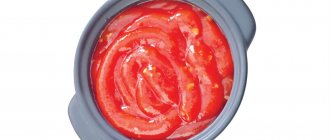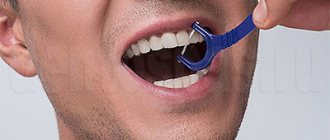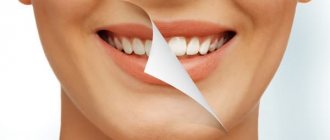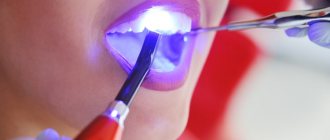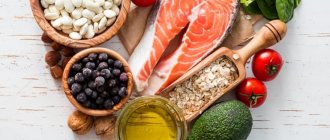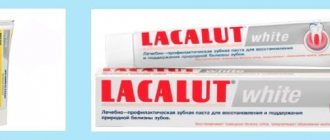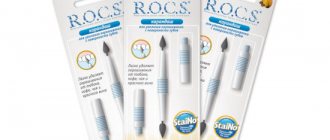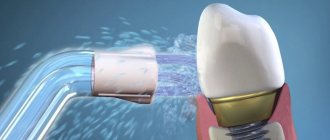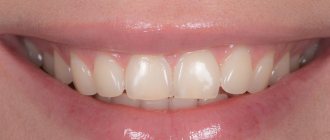Everyone wants to be the owner of a beautiful snow-white smile. This is why professional teeth whitening has become so popular recently. But in order for the result to be maximum and last a long time, you need to follow some rules for oral care. If you do not follow the specialist’s recommendations, fairly soon after the procedure your teeth will return to their previous shade.
Why do teeth become sensitive after whitening?
In the first days after the procedure, the enamel will be more sensitive; minor pain and reaction to temperature stimuli may occur. This is a completely normal phenomenon, since the teeth were exposed to aggressive external influences. However, there should not be acute pain - this situation indicates that the doctor chose the wrong dosage of the active substance.
Even the safest and gentlest whitening methods still have a negative effect on the enamel, destroying its mineral composition. Therefore, it is necessary to introduce healthy foods into the diet (see the list below), as well as use various preparations that will strengthen your teeth - in pharmacies you can purchase special pastes or compositions that are applied to the teeth for a few minutes.
Additional Tips
Here are some additional tips to help keep your teeth white:
- In the first hours after bleaching, it is important to refrain from eating food.
- It is advisable to quit smoking, since nicotine and tar from cigarettes lead to yellowing of the enamel.
- Women should be careful when using lipstick or lip gloss in the first weeks.
- To strengthen your teeth, you should increase your intake of foods with calcium.
- Mouth rinses should not contain chlorhexidine, which tends to stain enamel.
- At least twice a year, a consultation with a dentist with a preventive examination of the dentition is required.
As you can see, recommendations for caring for teeth after whitening do not pose any particular difficulties. The main thing is to strictly follow the doctor’s advice and eliminate all factors that may cause discomfort or affect the color of the enamel.
What diet should you follow after teeth whitening?
After bleaching, the enamel becomes more porous, and therefore there are certain restrictions in terms of nutrition and hygiene procedures. Therefore, after the lightening procedure, adhere to the “white diet”: exclude foods and drinks that contain coloring pigments and can lead to a change in the shade of the enamel. It is worth minimizing the amount of coffee, black tea, dark vegetables and fruits consumed.
To strengthen the enamel, introduce into your diet foods that contain large amounts of calcium and fluoride: milk, kefir, cottage cheese, fish, cheeses, eggs.
It is worth excluding factors that provoke unpleasant sensations, namely, too hard food, excessively hot and cold drinks. Follow the recommendation for an average of a week or longer, if necessary. It is also better to exclude sour and spicy foods from the diet: citrus fruits, sauces, ketchup, curry and other seasonings can increase tooth sensitivity.
How to behave after the whitening procedure?
- What recommendations should you follow?
- Soreness after a session: what does it mean?
- Dietary advice: what is prohibited?
- What is better to forget: bad habits
After a procedure that improves the shade of the dental surface, each of us has a rational question: “What to do after teeth whitening and what is it better to refrain from so that the effect lasts as long as possible?”
At first, after exposure, teeth become especially sensitive to various negative factors; they require high-quality and constant care. There is a list of rules that must be followed. It is their conscientious implementation that ensures that the dental rows remain white for many months.
Hygienic care rules
- Do not use a toothbrush with hard bristles - it will only increase the sensitivity that occurs immediately after the whitening procedure. It is better to give preference to a brush of medium hardness, since one that is too soft will not cope with removing plaque,
- Toothpaste should be free of abrasive substances that can damage the enamel. The best option is a paste to reduce hypersensitivity. It should be used for the first 2-3 weeks after whitening. Afterwards, it can be replaced with a paste that contains fluoride - this will be an excellent option for strengthening enamel and protecting against caries,
- After eating food (especially “coloring”), you should pay special attention to hygiene - use dental floss or a irrigator after each meal. And not only in the first days after whitening, but also in the subsequent ones - this recommendation should become a useful habit,
- Mouth rinses should not contain chlorhexidine, as it causes permanent staining of tooth enamel.
Even after whitening, you need to visit the dentist 1-2 times a year (but not earlier than six months later). Professional hygiene and removal of dental plaque will preserve the results and will be an excellent prevention of caries.
Women should avoid using lip gloss and bright lipstick for the first few days after whitening.
Rules for brushing teeth
You should brush your teeth after every meal. To clean, you need to use a brush with soft bristles, since bristles that are too hard can damage the enamel. Toothpaste should be designed for sensitive teeth. It is not recommended to use products with abrasives, and when purchasing a whitening paste, it is advisable to follow the advice of a dentist.
After cleaning, you should floss between your teeth. Dental floss provides more effective cleaning and allows you to remove food particles in hard-to-reach places. At the final stage, use a rinse aid containing fluoride. Its use allows you to remove remaining dirt and strengthen the enamel.
We know how to whiten teeth
Should I use home whitening products?
It is advisable to use homemade compositions to preserve the whitening results for a long time. But these should not be folk remedies, but professional ones, selected by your dentist. It is necessary to start using such compositions no earlier than 3 months after the professional procedure. It is better if the same system is used that was used in the clinic - for example, ZOOM or Amazing White - these brands provide formulations for use at home. But for this you will need to make individual mouth guards in which the active gel will be placed.
Whitening at home is especially effective for maintaining results after a professional procedure.
The effect of smoking on dental health
In the production of cigarettes, nicotine, tar, and chemical components are used, which settle in the micropores of the teeth, clog them and gradually change their shade from white to yellow and brown. The more a person smokes, the worse their teeth look. Nicotine and other substances in cigarettes disrupt blood circulation in the oral cavity and create favorable conditions for the proliferation of pathogenic microorganisms. Long-term smoking greatly weakens local immunity, thereby contributing to the development of not only caries, but also gingivitis, stomatitis and diseases of the ENT organs.
First, a yellow coating appears on a smoker’s teeth, mainly near the necks of the teeth, where stone most often forms.
Over time, brown plaque forms on teeth. They contain a large number of cariogenic microorganisms that produce acid and destroy tooth enamel.
This is why plaque on teeth after smoking cannot be ignored. If you cannot get rid of it at home, you need to seek help from a dentist. Statistics speak volumes about the impact of smoking on oral health: 40% of smokers aged 60-65 years are forced to use dentures due to the absence of most of their teeth.
Why is the diet called “white”?
The word “white” directly reflects the essence of the diet: only those foods that are not capable of staining teeth are allowed to be eaten. In dental practice, such a diet is also called colorless. In addition, the diet includes only healthy foods rich in calcium and other minerals that strengthen the enamel. Another advantage is that the calorie content of the menu is slightly reduced, which also allows you to slightly adjust your weight. The diet is based on natural protein and dairy products.
What can you eat after whitening?
There are enough permitted products to not feel strict restrictions and not worry about anything. In addition, the white diet is not only a developed program that is good for teeth, but also an excellent opportunity to improve your body’s health and get rid of a few extra pounds.
Available food products:
- fermented milk products with a small percentage of fat content;
- rice;
- fish;
- eggs;
- cabbage;
- potato;
- oatmeal;
- cucumbers;
- apples;
- bananas;
- lean white meats: rabbit, chicken, turkey;
- pasta;
- bread;
- white beans.
How long does the white diet last?
The white, also known as transparent diet, lasts exactly two weeks. After time has passed, it is not recommended to immediately switch to your previous usual diet, as you risk harming the digestive system. Do it gradually . To begin with, increase your intake of wheat (white) bread and add fatty dairy products to your diet. After this, you can switch to fatty broths, stewed vegetables, salads with the addition of oil and vegetables prohibited in the diet.
What does plaque on teeth from smoking look like?
Plaque on teeth from smoking is usually yellow or brown. A few hours after brushing your teeth, the enamel is covered with a microbial film, which is easily removed with a brush and toothpaste. But in a smoker, the immune system in the oral cavity is significantly reduced and the process of reproduction of cariogenic microorganisms is more active. Therefore, a yellow-brown plaque forms faster than in a non-smoker.
You can look at what plaque on your teeth from cigarettes looks like. It differs in shade and density, depending on the duration of smoking.
Some people develop black deposits on their teeth, which indicate serious problems in oral health and may indicate the development of deep caries. Carious cavities and spots are invisible under the plaque. They can hide the initial signs of enamel damage.
In addition to plaque, other symptoms appear when smoking:
- bad breath;
- bleeding gums;
- exposure of the necks of the teeth;
- increased sensitivity of enamel;
- early tooth loss.
But infectious complications, which often arise when plaque on teeth from smoking is ignored, can be avoided. To do this, it is necessary to constantly maintain high quality oral care, carry out professional cleaning in the dentist's office and use home enamel lightening methods.
Smoking after tooth extraction
Modern dentistry offers effective and painless methods of tooth extraction. Patients do not experience any discomfort during the procedure, but they are still worried and cannot resist smoking a cigarette after the treatment is completed.
However, dentists believe that smoking and dental health are incompatible things.
Cigarettes after removing affected teeth, especially if we are talking about wisdom teeth, can cause complications. In addition, tobacco smoke has an irritating effect on the wound surface, causing pain and aggravating inflammation. Smokers are advised to abstain from the habit at least in the first day after removal, and better yet, until complete healing.
Condition of teeth in a smoker
The dentition of a smoker has characteristic changes that occur with prolonged use of cigarettes in large quantities:
- Formation of tartar containing tobacco combustion products in large quantities.
- The gums become looser, which leads to the gradual progressive formation of periodontal pockets. Food debris accumulates in these cavities, increasing the risk of developing an infectious process.
- The effect of smoking on teeth is the severe destruction of enamel, which begins with microscopic damage and ends with deep cracks.
- Gradual destruction of the tooth from the inside. In advanced cases, pieces may break off when chewing solid food.
- Reducing the size of crowns and expanding the distances between them due to sedimentation of the mucous membrane. Gradual loosening of teeth followed by their loss.
Gradual damage to the dentofacial apparatus progresses and spreads beyond the oral cavity, affecting the larynx.
How does tobacco affect the oral mucosa?
The teeth of a healthy person and a smoker also differ in that the latter are much more likely to have problems with the oral mucosa. The mildest of these are dry mouth (xerostomia) and an unpleasant odor, which increases due to the breakdown of components of tobacco products. Due to inhalation of hot smoke, tobacco stomatitis and leukoplakia often occur - compacted spots on the mucous membrane, framed by a white coating. In heavy smokers, doctors often diagnose leukokeratosis, which manifests itself in the form of seals (usually on the lower lip). This disease may well be a precursor to cancer, since the tumor often becomes malignant over time. Smoking often becomes one of the causes of gingivitis and periodontitis, and also significantly complicates the treatment of any inflammatory processes in the periodontium.
How to maintain the effect of teeth whitening
Despite all the benefits of the white diet, it will not be possible to maintain the achieved results only with its help. Dentists also advise patients:
- Don't forget to use dental floss and a special mouthwash after meals.
- Properly brush your teeth twice a day for at least 3-5 minutes.
- Use high-quality toothbrushes and toothpastes.
Following all these simple recommendations will allow your teeth to remain snow-white for a long time. And you - to delight others with a dazzling Hollywood smile.
sign up for a consultation
Smoking after dental implantation
Dental implantation is one of the most common prosthetic methods, which allows you to achieve an ideal aesthetic and functional result. There are many reasons why you should give up a bad habit during the procedure and recovery:
- slowing down the rate of healing of wound surfaces after implant installation;
- slower engraftment of the implant in the bone tissue, as well as an increased risk of rejection;
- increased risk of infection and development of pain syndrome;
- negative impact on the appearance and functional properties of the crown after installation.
Smoking harms not only natural teeth, but also artificial crowns, gradually affecting their color. A bad habit causes the structure to serve less than it should. You have to change crowns more often, which are not cheap.
How does tobacco affect teeth?
When inhaled, tobacco smoke enters the oral cavity and spreads over its entire area, affecting both the teeth and the mucous membrane. That is why smoking causes complex harm, and complications in the future can extend far beyond the oral cavity. For a better understanding, we need to talk about each negative factor separately. Let's start with the teeth.
- Plaque and hard deposits. Many people wonder why smokers' teeth turn yellow. When smoking tobacco, tars and combustion products settle on the enamel, causing the characteristic smoker's plaque to form on the teeth. The higher your tobacco consumption, the more difficult it is to remove such plaque. As you know, over time, soft plaque hardens, tartar forms, and teeth acquire a characteristic yellow-brown tint. This means that the dyes have penetrated deep into the enamel and dentin.
- Smoking and tooth decay. Smoking is one of the factors that provokes the development of caries. There are several reasons for this. Firstly, tobacco smoke provokes the formation of microcracks on the surface of the enamel, which reduces its protective functions. Secondly, when smoking, the process of salivation is disrupted and dry mouth appears. As you know, saliva contains mucins that prevent the formation of a bacterial film. Add to these factors poor hygiene - and caries cannot be avoided.
Why do smokers get toothache?
The destructive effect on tooth enamel leads to toothache from smoking . The mechanism of pain is associated with several factors:
- increased overall sensitivity due to thinning of the enamel;
- inflammation of the gums due to the penetration of bacteria;
- development of pulpitis (inflammation affecting the root).
Increased sensitivity leads to the fact that a person feels pain when eating foods that are too cold or hot, sweet, sour, or overly spicy foods. Gradually, the situation worsens, then any impact on the damaged enamel begins to cause pain.
